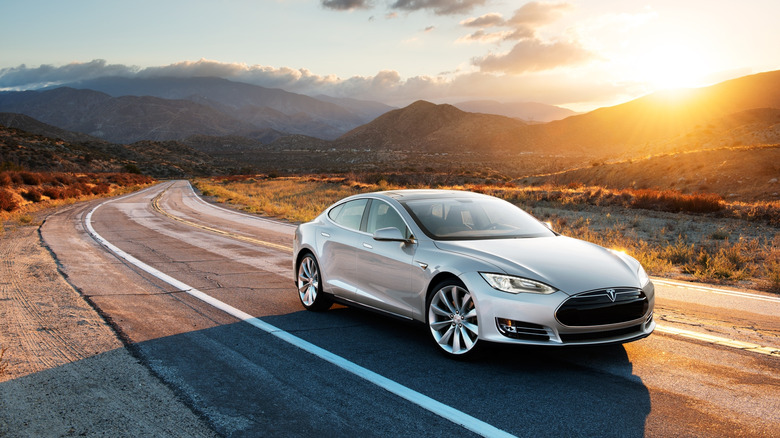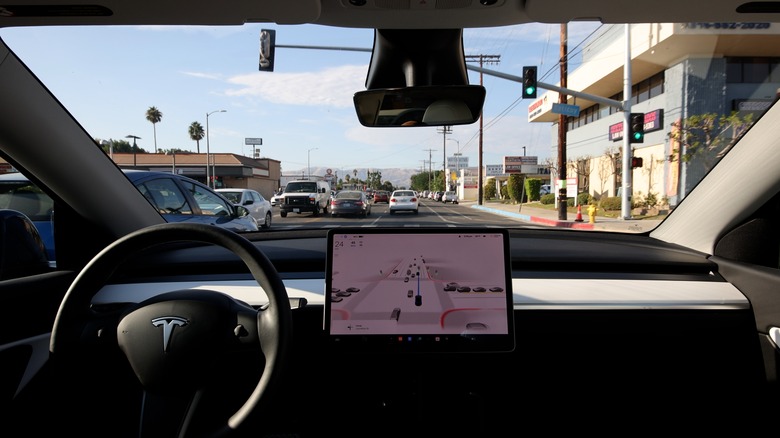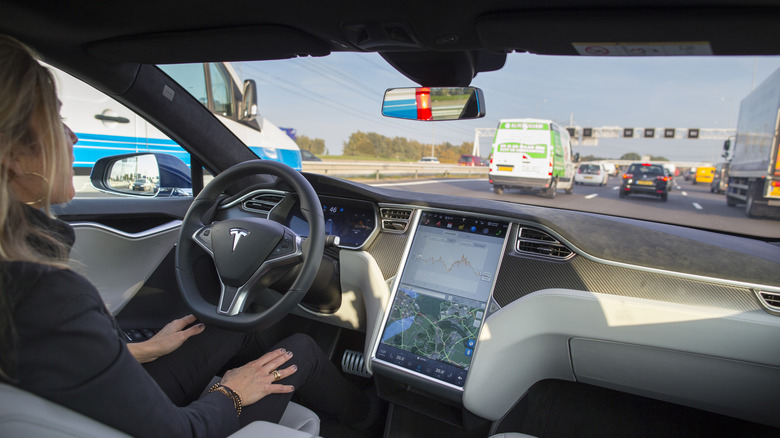How To Turn On Autopilot In A Tesla Model S
Tesla's Autopilot feature has been around since 2014 (via Tesla), but the feature is really coming into its own these days. The driver assistance features are focused on vehicle and driver safety, as well as infusing increased functionality into the car and making it more helpful to drivers on their daily commutes.
While Tesla notes that a driver using the advanced driving features should always remain alert and in control of their vehicle, the driver assistance add-ins certainly make driving fun and far less stressful. In addition to lane changing, collision detection and avoidance, and speed control, Tesla reports that the Autopilot functionality can park the car for you, and even summon it from a parking space.
These advances in vehicle function make driving a different kind of experience. Instead of having to remain laser-focused on the road, it's entirely possible that a vehicle can transition into a kind of automated taxi service for the driver during some of the most monotonous parts of a commute or extended voyage. A trip to your vacation home a few hours down the road, for instance, could become something of a train journey, where all the car's occupants can engage with one another freely. Today's Autopilot requires attention still, but it's incredibly easy to use.
How to engage Autopilot in the Tesla Model S
Tesla states that before engaging the Autopilot features, drivers must agree to a prompt noting that hands must be kept on the vehicle's steering controls at all times. Tesla also makes note of the fact that fully autonomous driving isn't yet a reality for these advanced automation features, even as they provide immensely accurate steering, speed, and braking control. These enhancements may be coming in the future, but they are not a reality as of yet.
To engage the driver assistance features, you'll want to first decide on which feature is most appropriate for the situation.
To autosteer your Tesla Model S:
- Pull the cruise control stalk toward you twice.
- A grey steering wheel will appear next to the speedometer when the system is ready.
- When the system is engaged, the wheel will change to blue.
- You'll then need to keep your hands on the wheel to maintain the autosteer function.
To initiate automatic lane change:
- Activate autosteer.
- Hold the steering wheel.
- Confirm a lane change operation by engaging the turn signal in the desired direction.
To use Autopilot navigation:
- First navigate to Autosteer options on your control panel by selecting Controls > Autopilot > Autosteer.
- Then enable the "Navigate on Autopilot" option.
- Ensure that your cameras are calibrated and the latest navigational maps are downloaded.
- Select "NAVIGATE ON AUTOPILOT" in your Navigation Turn List to use this feature while driving.
Tesla Autopilot can make roads safer
So far, the use of Tesla's Autopilot features appears to be making roadways a safer place to be. In typical driving environments across the United States, Next Big Future reports that roughly one fatality per month occurs in every 100,000 drivers, with 163 injuries due to accidents per 100,000 drivers monthly. Tesla's full self-driving beta test was adopted by more than 100,000 participants as of April 2022, and in the four month period preceding Next Big Future's reporting, not a single injury or fatality has been reported among these vehicles using autonomous road navigation.
In June of 2022, The New York Times reported that while self-driving programs have been on U.S. roadways since 2015 — and their statistics showcase lower incidents of accidents and fatalities — the function is primarily used for highway driving. This skews the results, as The Times notes that driving on the highway is twice as safe as taking to city streets. Still, this is a major win when it comes to promoting roadway safety and responsible driving.
While drivers may have visions of a utopian future with roadways filled with self-driving cars and relaxing vehicle operators, this prospective future remains far off. Self-driving features in cars have been conceived of for a long time, but progress toward functional roadway control is slow as research and technological innovation continues steadily. Plus, despite testing indicating that Autopilot improves rider safety, Tesla's self-driving vehicles are still not immune to accidents.
That being said, with the help of Autopilot and an EV that costs less to 'gas up' than a vehicle running on gasoline, commuters can effectively expand their range while reducing some of the stress of highway driving.


